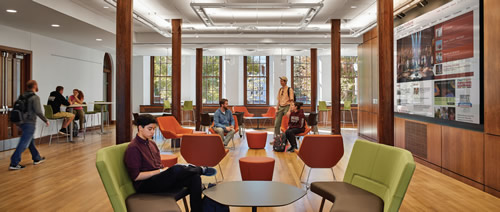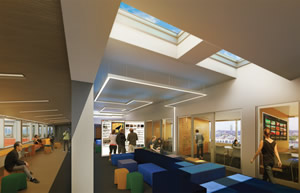Everything I Learned About Learning in Kindergarten

Photo courtesy of Finegold Alexander Architects
Contrasting pictures come to mind when recalling historically typical learning spaces: from rows of flip-top desks with attached chairs, bolted to the floor, all facing forward toward a blackboard; harkening back to single-room schoolhouses in rural America where younger children would sit up front, older children at the rear of the room, in near total silence, working at their “lessons.”
This model—perhaps in multiples to make up a larger school—might appear anywhere in the country. For decades, the idea of classroom as a place where the teacher—the imparter of knowledge—stood at the front of room purveying information which the pupil was to note and absorb ruled. Despite educators’ best efforts to change this, the one-way flow of knowledge and information has dominated our learning culture.
New Ideas Emerge
In the early part of the 20th century, new concepts began to emerge relative to educating young children. Driven particularly by Maria Montessori, the idea of the child as the center of the education process arose. The first “Casa Del Bambini,” or Children’s House, opened in 1907.
Two central tenets of what is now known as the Montessori method which have been incorporated into modern-day thinking about education are the prepared environment and auto-education. The Montessori education space has several compelling physical characteristics:
- The space should be filled with readily available and well-organized learning materials, be aesthetically pleasing, and only include things that the teacher wants the child to experience.
- The materials placed within should engage children from different ages, characteristics, and interests.
This inherent engagement with the environment aids auto-education—the child engaging in exploration with other learners and acquiring not just knowledge, but also the skills required to thrive in the world.
Today, ideas deriving from Montessori dominate best practices for the design of early education spaces. Schools identifying themselves as progressive set up pre-K and kindergarten classrooms—not with rows of chairs facing a teaching wall—but instead, with multiple activity areas for guided play. Tables for groups of students to work together abound, with access to varied materials and different ways of engaging, from lounging on a beanbag to read with a friend or working together to create a structure in a block area. These varied areas and materials adapted to different learning styles furthered the notion of a child-centered—and learner-centered—environment.
Studies demonstrated that this model worked and, in fact, the model even crept into the early grades after kindergarten. Yet for many years, by third or fourth grade, classrooms stayed largely unchanged. As students moved up through the grades, flexible tables, soft seating areas, and cubbies gradually gave way to rows of desks, lockers, and fixed lecture-hall seating.
Reaching Higher Education
Despite the effectiveness of engaging learners into the process of educating themselves, by the time you reached higher education, you were once again that pupil being “taught to.” Students are looking only to the front of the room, passively absorbing knowledge—or perhaps napping after a long night attempting to complete an essay or problem set—waiting to be told what is going to be on the final so they know what to study and what can conveniently be forgotten.
This shift in the design of learning environments as learners moved toward adulthood occurred despite theories of “active” or “self-directed” learning that emerged in North America as early as the 1970s related to adult or pre-adult learners. Studies throughout the 1980s stated that active learning must involve higher-order thinking, including analysis, synthesis, and evaluation. (See the excellent compilation of these studies as presented by Bonwell and Eison in Active Learning: Creating Excitement in the Classroom.) While lecturing has still been shown as sometimes superior for content transmission, it is not as beneficial for building thinking and writing skills.
Faculty have been encouraged to find ways to break lectures down by including pauses—demonstrations, watching videos with no notes, taking a break to make notes, even working briefly in groups. However, current classroom and learning environment designs do not follow suit.
Lecture halls make group interactions difficult and emphasize the passivity of the learner. When instructors move about (as they do in the kindergarten classroom), they can engage more directly with students and they can read understanding (or lack thereof) in the students’ faces. Students may be more likely to engage in a format with direct teacher contact, rather than raising their hand in a sea of hundreds. Explaining something they understand to others in a small group provides another layer of reinforcement and emphasizes peer-to-peer learning.
Even within subjects as dependent on intensive knowledge acquisition such as Physics, studies have shown that active learning techniques and their correspondingly different classroom designs contribute to deep learning. The President’s Council of Advisors on Science and Technology’s first recommendation of their 2012 report was as follows: “Catalyze widespread adoption of empirically validated teaching practices.”
Active Learning
Learning theory, empirical evidence about how people learn, and assessment of outcomes in STEM classrooms all point to a need to improve teaching methods to enhance learning and student persistence. Classroom approaches that engage students in “active learning” improve retention of information and critical thinking skills, compared with a sole reliance on lecturing, and increase persistence of students in STEM majors.
Learning in a university setting does not occur solely in a lecture hall or classroom. With widespread inclusion of technology and high-speed WiFi, everywhere is a learning space. Learners set the pace, working where and how they wish. How can our learning environments best support this self-direction?
Let’s go back to that kindergarten environment for a moment…

Photo courtesy of Finegold Alexander Architects
Kindergarten students can sit in a quiet corner and read; work at a table with a small group of friends; gather around a screen with headphones; and then quickly shift their attention to the teacher who moves among them. Close your eyes for a moment and you can see these same types of activities in a flexible university classroom with breakout areas in the adjacent corridor, or within a university library and common areas of residence halls. Creating spaces that facilitate varied learning modalities and support active learning throughout the campus is key.
Our firm is working with Boston University (BU) on a variety of projects that create conditions for the learner to flourish. These include the renovation of a major floor of Kilachand Hall, home to the Honors College, to provide group and individual study and instruction areas. From placing a seminar room within a study/social area, to group study rooms openable to a flexible “sandbox” equipped with moveable furniture and writable surfaces, many modes of learning are supported. The Honors College director wanted to insure students could be both “in their heads,” thinking deeply, and yet be with other students. Why? Because working with others is key to solving today’s problems.
The Learning Resource Center for BU’s Medical Campus will enable quiet, heads-down thinking with large carrels that shield the learner from distractions, or “pods” that enable a feet-up, kick-back approach. Also provided are spaces for small group meetings and napping—yes, napping! Everyone needs to recharge to flourish.
As designers for higher education we must create spaces that facilitate deep thinking, encourage critical problem solving, and engage learners to solve society’s most urgent challenges. Doing so requires returning to principles for early childhood education: fostering wonder and engagement so that students learn to love learning. Let’s get back to what works, even if it means we need to go back to kindergarten.
This article originally appeared in the College Planning & Management October 2018 issue of Spaces4Learning.